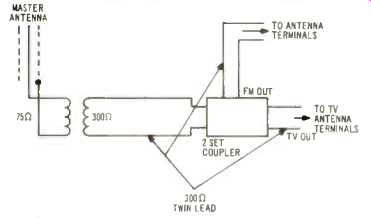FM Reception and Master Antennas
Q. I often listen to FM in my apartment, which is fairly close to several FM stations. I have tried several coupling devices in order to use the apartment building's roof-top TV antenna, which only resulted in poor reception for both the FM and TV sets, no matter what I did.
I am forced to use a T-shaped arrangement which I stretch out on the wall behind my tuner. This looks awful and does not give satisfactory results. The same is true of an adjustable TV dipole (rabbit ears) which I tried.
Nowhere have I read or heard of an FM antenna for people who cannot put up a roof-top installation or project something from a window because of apartment house rules.
Do you know of an adjustable indoor table model which is beyond the dipole stage and specifically designed for FM?
-Claudia Grill, Palo Alto, Calif.
A. Unfortunately, no breakthroughs have come along in terms of indoor antennas. Fortunately, however, the common dipole does do a reasonably good job for enough people that FM listening is worthwhile to them, but I do realize that not every one will be lucky.
There are rabbit-ear antennas which in addition to having a length adjustment for each element, also provide a system for changing the phase relationships between the two sections. Such antennas sometimes bring about improved reception.
I judge that your master system was not designed to receive FM stations.
Such an installation is often set up to reject all but the TV channels. If enough tenants in your building complain, perhaps the antenna system could be redesigned to include the FM band.
On the chance that your master antenna does include provisions for FM reception, the following information may be useful.
Master antenna systems are usually 75 ohm installations. Your FM and TV equipment is, in all likelihood, only equipped for 300 ohm antennas. On top of all this, the master antenna uses unbalanced coaxial line, while your equipment requires a balanced input circuit. To overcome all of this you need to use a transformer which is 75 ohms to 300 ohms. You will also need a 2-set coupler which is designed to interconnect the FM set, TV set and transformer. The connections are shown in Fig. 1. In addition, instructions are usually provided with both the transformer and the coupler.

Fig. 1--Interconnection of TV, FM & master antenna.
By the way, the newer variety of couplers are so made that it is no longer necessary to strip the insulation of the 300 ohm twin lead. The screws which secure the wire to the coupler are so made as to cut into the insulation and make firm contact with the conductors.
Oxide Deposits
Q. I have a problem with oxide deposits on the record/playback head I clean the head lubricate it, and within four to five hours of use there is oxide visible on the head and there is a noticeable high frequency loss. The pressure pads don't seem to be excessively strong.
Would changing tape be a solution to my problem? Is this kind of wear harmful to tapes over a period of time?
-Steven R. Wagner, Augusta, Ga.
A. All tapes deposit oxide on the heads (with the exceptions of some special coated tapes); depending on the particular tape machines with which the tapes are used, some may do so more than others. Therefore it is worthwhile following up your thought of trying various brands of tape, particularly those of well-known, reputable manufacturers. If they all deposit excessive oxide, your pressure pads may be at fault and should be checked.
Does your machine have a tape lifter to space the tape away from the heads during rapid wind? If not, this may be the cause of your problem. Then try to wind the tape directly from reel to reel, and not past the heads; or insert a piece of celluloid between the tape and the heads during rapid wind.
Rapid oxide wear on a frequently used reel of tape is apt to harm the tapes and the heads.
(Audio magazine, Jan. 1972, Joseph Giovanelli)
= = = =